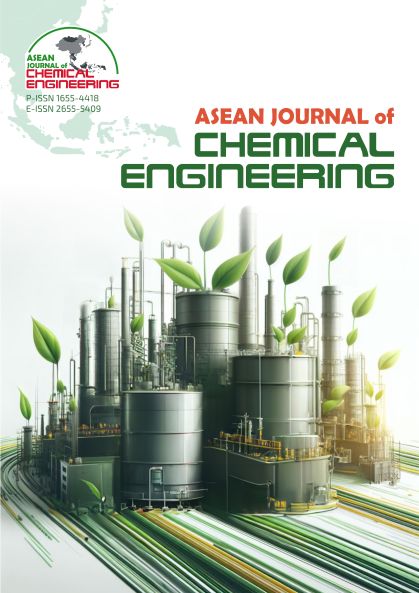Studies on Encapsulation of Gas Releasing Agent in Ca-Alginate Beads and Controlled Release Pattern of the Beads
Abstract
Calcium alginate beads have been used to control release gases and volatile compounds for agricultural applications, drug delivery, waste treatment, and food product enhancement. The release rate of the gas and vapor depends on the diffusion of gas and vapor through the Ca-alginate gel matrix. However, the knowledge about the effect of process variables on the diffusion rate of gas and vapor still needs to be improved. Therefore, this study aims to investigate the effect of alginate concentration, gas release agent concentration, and bead size on the concentration of gas released from Ca-alginate beads. In this study, calcium carbonate was used as the model gas release agent, encapsulated in Ca-alginate beads to release carbon dioxide when the beads reacted with an acetic acid solution. The results showed that the concentration of carbon dioxide released by the beads depended on the bead diameter. The gas release rate was increased when the diameter of the beads was increased. The total amount of gas produced by the large beads was observed to be higher than that of small beads. Compared to small beads, large beads take longer to react completely to produce carbon dioxide gas. It was also found that the amount of carbon dioxide produced by the Ca-alginate beads was inversely proportional to alginate concentration but directly proportional to calcium carbonate concentration. The results indicated that the gas diffusion rate of the Ca-alginate beads can be tailored by adjusting the process variables of the Ca-alginate bead encapsulation process.
References
Cha, Y.-J., Kim, J.H. and Yu, D., 2021. "Preparation of macro fragrance capsule and its stability during storage." J. Korean Soc. Food Sci. Nutr. 50(4), 420-427.
Chan, E.-S., Lee, B.-B., Ravindra, P. and Poncelet, D., 2009. "Prediction models for shape and size of Ca-Alginate macrobeads produced through extrusion–dripping method." J. Colloid Interface Sci. 338(1), 63-72.
Choi, B., Park, H., Hwang, S. and Park, J., 2002. "Preparation of alginate beads for floating drug delivery system: Effects of CO2 gas-forming agents." International Journal of Pharmaceutics 239(1-2), 81-91.
Fortunato, L.R., Parsekian, G.A. and Neves Junior, A., 2023. "Developing an easy-to-build laboratory chamber for CO2 experiments." Matéria (Rio de Janeiro) 28(2), e20230078.
Lee, B.-B., Ravindra, P. and Chan, E.-S., 2009. "New Drop weight analysis for surface tension determination of liquids." Colloids Surf., A 332(2-3), 112-120.
Lee, B.B., Ravindra, P. and Chan. E.S., 2013. "Size and shape of calcium alginate beads produced by extrusion dripping." Chem. Eng. Technol. 36(10), 1627-1642.
Lee, C.-S., Le Thanh, T., Kim, E.-J. Gong, J. Chang, Y.-Y. and Chang, Y.-S., 2014. "Fabrication of novel oxygen-releasing alginate beads as an efficient oxygen carrier for the enhancement of aerobic bioremediation of 1, 4-dioxane contaminated ground-water." Bioresour. Technol. 171, 59-65.
Liu, Z., Shao, M., Junejo, S.A., Zhang, B., Jiang, H., Fu, X. and Huang, Q., 2023. "Controlled ethylene-releasing from V-Type starch coated with sodium alginate for banana ripening via changing the humidity of environment." Postharvest Biol. Technol. 202, 112377.
Magdhut, P., Dandagi, P.M., Kokatanur, U.A. and Patil, A.S., 2023. "Multiparticulate floating beads an aid to enhance therapeutic efficacy of rabeprazole." Ind. J. Pharm. Edu. Res. 57, 540-547.
Paris, M., Ramírez-Corona, N., Palou E. and López-Malo, A., 2020. "Modelling release mechanisms of cinnamon (Cinnamomum zeylanicum) essential oil encapsulated in alginate beads during vapor-phase application." J. Food Eng. 282, 110024.
Petzold, G., Gianelli, M.P., Bugueño, G., Celan, R., Pavez, C. and Orellana, P., 2014. "Encapsulation of liquid smoke flavoring in Ca-Alginate and Ca-Alginate-Chitosan beads." Journal of Food Science and Technology 51(1), 183-190.
Rasel, M.A.T. and Hasan, M., 2012. "Formulation and evaluation of floating alginate beads of diclofenac sodium." Dhaka Univ. J. Pharm. Sci. 11(1), 29-35.
Russo, P., Morello, S., Pinto, A., Del Gaudio, P., Auriemma, G. and Aquino, R.P., 2020. "Zinc and calcium cations combination in the production of floating alginate beads as prednisolone delivery systems." Molecules 25(5), 1140.
Soliman, E.A., El-Moghazy, A.Y., El-Din, M.M. and Massoud, M.A., 2013. "Micro-encapsulation of essential oils within alginate: Formulation and in vitro evaluation of antifungal activity." J. Encapsulation Adsorpt. Sci. 3(1), 48-55.
Takka, S. and Acarturk, F., 1999. "Calcium alginate microparticles for oral administration: I: Effect of sodium alginate type on drug release and drug entrapment efficiency." J. Microencapsulation 16(3), 275-290.
Treesinchai, S., Puttipipatkhachorn, S., Pitaksuteepong, T. and Sungthongjeen, S., 2019. "Development of curcumin floating beads with low density materials and solubilizers." J. Drug Delivery Sci. Technol. 51, 542-551.
Zhang, H., Cheng, J. and Ao, Q., 2021. "Preparation of Alginate-based biomaterials and their applications in biomedicine." Marine Drugs 19(5), 264.
Copyright (c) 2024 ASEAN Journal of Chemical Engineering

This work is licensed under a Creative Commons Attribution-NonCommercial 4.0 International License.
Copyright holder for articles is ASEAN Journal of Chemical Engineering. Articles published in ASEAN J. Chem. Eng. are distributed under a Creative Commons Attribution-NonCommercial 4.0 International (CC BY-NC 4.0) license.
Authors agree to transfer all copyright rights in and to the above work to the ASEAN Journal of Chemical Engineering Editorial Board so that the Editorial Board shall have the right to publish the work for non-profit use in any media or form. In return, authors retain: (1) all proprietary rights other than copyright; (2) re-use of all or part of the above paper in their other work; (3) right to reproduce or authorize others to reproduce the above paper for authors’ personal use or for company use if the source and the journal copyright notice is indicated, and if the reproduction is not made for the purpose of sale.



